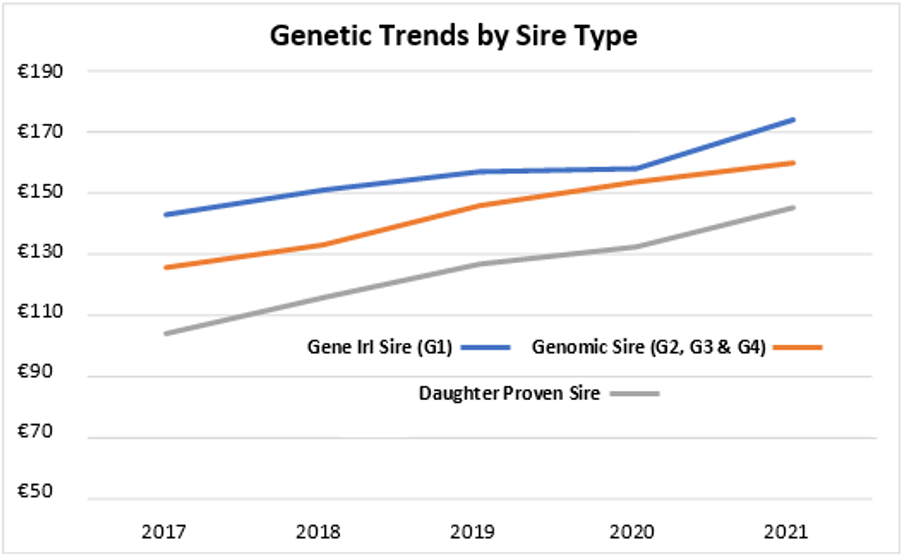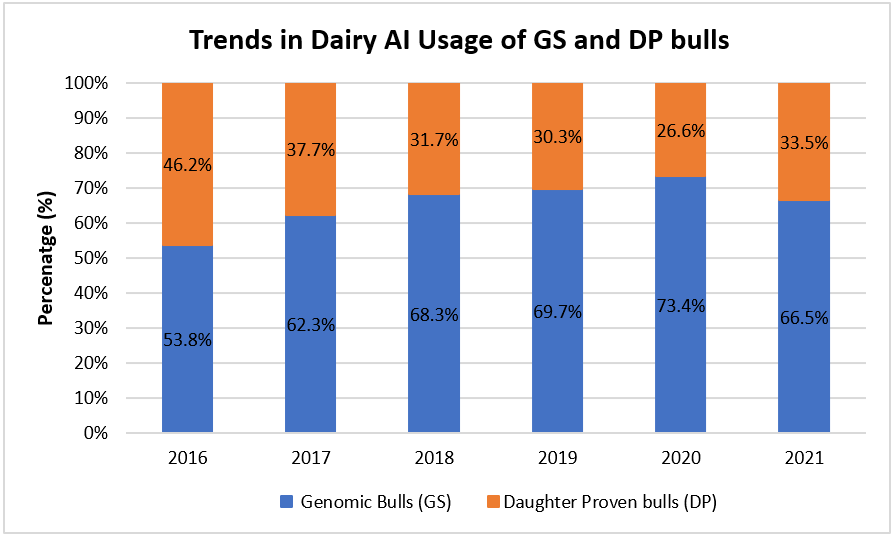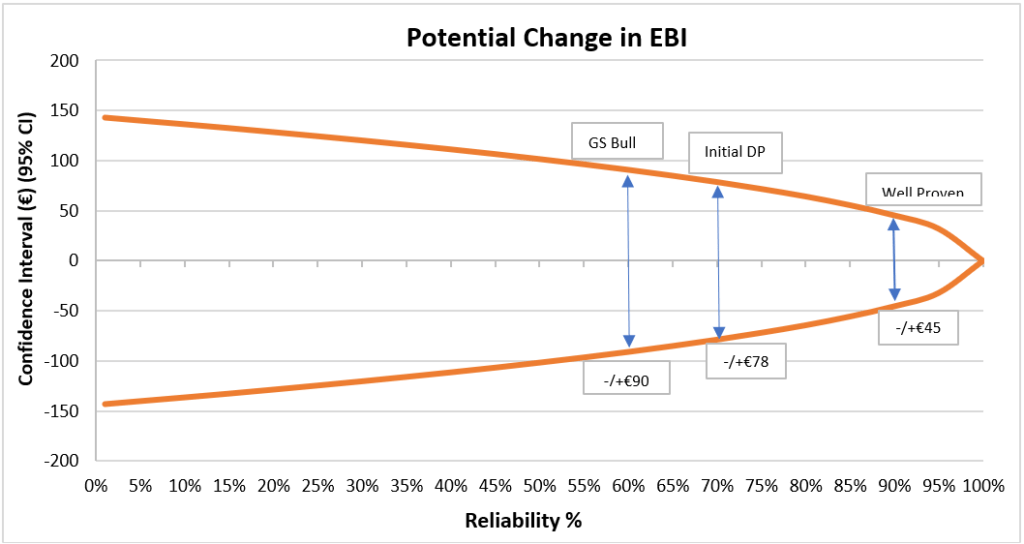The selection of dairy AI Sires has changed enormously since the implementation of genomic technology in Ireland over 13 years ago. When it comes to selecting AI sires to breed the next generation of dairy replacements, farmers have two potential options, to use genomic bulls or daughter proven bulls. Genomically Selected (GS) bulls have their own calving ease proof but have no daughters in milk production. Daughter Proven Bulls (DP) have their own calving ease proof and milk production proof based on his daughters that are in milk production. Its important dairy farmers have a clear breeding policy as it will have a significant impact on their farm profitability and sustainability.
Genetic Trends
The key concept regarding young genomic dairy bulls is that on average these young bulls have a greater genetic merit than the proven bulls. This can be seen clearly in graph 1 below. The analysis shows the genetic trend of first calving females broken down by their sire type, over the last 5 years.
The average EBI of progeny from Genomic bulls and Daughter proven bulls in 2021 was €165 and €145 respectively. As expected, the average EBI of female progeny from the new generation of young bulls (G1 Bulls) have the greatest genetic merit, with an EBI of €173. Progeny from Genomic bulls are consistently €20-€30 higher EBI compared to progeny from Daughter proven bulls across the five years. This is equivalent to 3-4 years of genetic gain. Selecting genomic bulls will increase profitability as every €1 increase in EBI can result in an increase of €2 in profit based on research from Teagasc.
Graph 1. The genetic trend by year of first calving females by GS bulls and DP bulls (2017-2021).

The trends in Genomic bull usage have been consistently greater than daughter proven bulls over the last number of years. This is presented in graph 2 below and the increasing impact of genomics. The usage of genomic bulls has gone from 53.8% to 66.5% over the last 6 years on dairy farms. The greater usage of young Genomics bulls than Daughter proven bulls can be attributed to the superior level of genetics being offered to famers. The analysis confirms that dairy farmers continue to have increased confidence in young genomically selected bulls.
Graph 2. Trends in AI bull usage, based on 1st calving dairy females born each year (2016 to 2021).

Managing risk and Team of Bulls
It’s extremely important to note that all bull proofs can change as more information is collected on them, irrespective if the bull has a genomic or daughter proven proof. Proofs can rise or fall as the reliability increases on breeding values. Daughter proven bulls that are proven for milk traits only can still change in the order of -/+ €78. They still have a large amount of genomics contributing to their EBI. As expected, Genomic bull proofs do move more due to lower reliability (e.g., no milk daughter records). This is illustrated on graph 3 below, on the potential EBI changes. Well proven bulls that are proven for both milk and female fertility (reliability of greater than 90%), their EBI can still change in the order +/-€45.
Graph 3. Potential change in EBI for an individual AI bull based on reliability.

The question is how farmers should proceed next when selecting AI sires. Should farmers use young genomic bulls because they have greater breeding values or instead use daughter proven bulls because they have more reliable breeding values? The selection of sires should be always based on breeding values, and the reliability should be used as a guide to decide how intense to use a bull. Thus, the best breeding policy for farmers is to use a team of genomic bulls equally across the herd. The guidelines for bull team usage are presented in table 1. The benefit of using a team of bulls is that the reliability of the average genetic merit of the team is considerably greater than the reliability of each individual bull. This will minimise the risks of bulls falling in EBI and negatively impacting the genetic merit of the progeny.
Table 1. Guidelines for bull team usage
| Herd Size (Inc. Heifers) | Recommended minimum number of Bulls |
| 0-100 | 7 |
| 100-150 | 8 |
| 150-200 | 10 |
| 200-250 | 11 |
| 250-300 | 12 |
| 300-350 | 13 |
| 350-400 | 14 |
The Comparison of EBI and herd performance
The use of genomic bulls opposed to daughter proven bulls to increase dairy farm profitability is further reinforced by the analysis of the EBI and 2021 herd performance from herds using mainly GS or DP bulls (for the milk traits) to breed their heifer replacements. This is presented in table 2. In the analysis, Spring calving herds were categorised into two groups, herds that had 70% or greater of their AI bred heifers born (from 2016 to 2019) to GS or DP bulls. These are now the cows that have formed the basis of their herds.
Table 2. Comparison of EBI and herd performance for herd mainly using GS or DP bulls to breed their heifer replacements.
| On-Farm Performance 2021 | Genomic Bulls | Daughter Proven Bulls |
| No. Cows/herd | 115 | 114 |
| Herd EBI (€) | €144 | €115 |
| % AI bred heifer calves born (2016-2019) | ≥70% | ≥70% |
| Litres/cow | 5,742 | 5,473 |
| Milk Solids kg/cow | 462 | 441 |
| SCC | 167 | 175 |
| Calving Interval (days) | 379 | 386 |
| 6-week Calving Rate (%) | 73 | 68 |
| Heifers calved at opt age (%) | 84 | 73 |
The analysis shows that herds using primarily GS bulls have a higher genetic merit, milk solids per cow and better fertility performance compared to herds that are primarily using daughter proven bulls. The difference in the herd EBI was +€29, milk solids per cow was +21kgs, calving interval was -7 days, and the 6-week calving rate was +5%. The difference of the % of heifer calving at the optimum age was +11%.
Summary
When deciding to choose daughter proven or genomic bulls, farmers should use a team of genomics bulls. The analysis clearly confirms the use of genomic bulls is delivering more profitable dairy genetics. Progeny out of genomic bulls are consistently higher EBI and delivering better production and fertility than progeny out of daughter proven bulls. Farmers will make much faster genetic progress using a team of genomic sires than a team of daughter proven sires. To manage risk and to maximise the benefits of genomic technology, use a team of GS bulls equally when breeding your dairy herd replacements.
